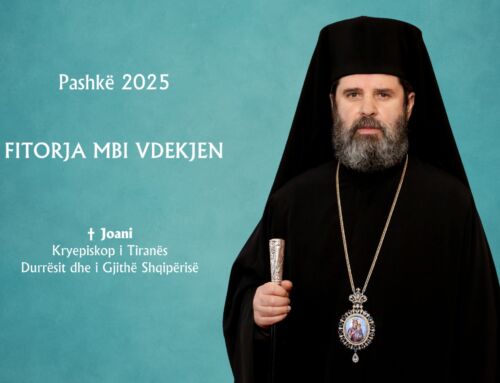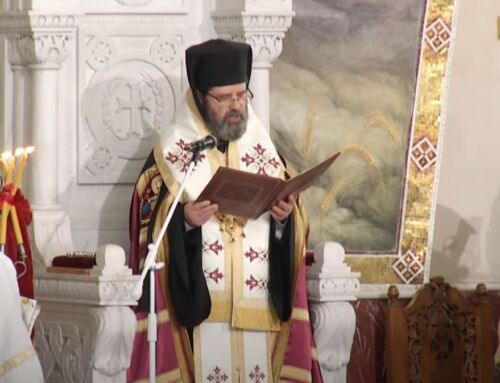Cultural Renaissance
In the East, in the tenth century, there was a general continuation of the cultural renaissance of the ninth century. The writings of the Church fathers were collected. For the first time, Saint Simeon Metaphrastes codified the Church’s Lives of the Saints. There was also a renewed interest in pagan antiquity led by such men as Michael Psellus and John Italos whose extreme “hellenization” led to conflicts with the Church.
In 960 Saint Athanasius of Mount Athos (d. 1000) founded the Great Lavra and thus opened the way to the development of the great monastic republic on the Holy Mountain. Saint Simeon the New Theologian (d.1022) wrote his influential treatises about the indwelling of the Holy Spirit in Christians.
Church and State
The tenth century also saw the increasing interpenetration of ecclesiastical and civil aspects of Byzantine Society. The Church received greater control over such matters as marriage and the family. For example, a church blessing â regulated by Orthodox canon law â in time comes to be required if a marriage is to be acknowledged as valid by the civil authorities. At the same time, the Church had to become more concerned with establishing “minimum requirements” than it had been earlier. This can be seen in the so-called “fourth marriage dispute.”
In 925 the patriarch of Constantinople Nicholas Mystikos refused a fourth marriage to the emperor Leo VI, thus bringing into Orthodox canon law the strict prohibition of a fourth marriage in the Church to anyone, under any circumstances. This historical act is the origin of the grossly erroneous opinion that the Orthodox Church “allows” three marriages to its faithful.
The Churchâs theology of marriage upholds perpetual monogamy as its standard: a union of one man and one woman which is not destroyed even by death. Remarriage, even of widows and widowers, does not conform to this standard, even though it may be accepted as a concession to human weakness.
The beginning of the tenth century witnessed for the first time the “rite of crowning” as a separate marriage service apart from the context of the divine liturgy in which marriages were previously performed as sacramental actions of the Church. Civil law established the practice of “legal marriage” apart from the sacramental marriage of the Church. It also established a special secular form for the adoption of children which was also previously done only by the action of the Church.
Bulgaria
In 918 Tsar Boris the Bulgarian, who was baptized in 869 with Michael III of Constantinople as his godfather, finally turned from Rome to Constantinople, thus establishing his church firmly within the Eastern family of Churches using the Slav language and the Byzantine liturgy. Particularly under his son, Tsar Simeon, Bulgaria was a powerful state and a Byzantino-Bulgarian culture flourished. However, by the end of the century, the heresy of the Bogomils – a dualistic, spiritualistic sect of the Manichaean tradition â was spreading.
Vladimir of Kiev
In 988 the subjects of the Kievan principality were baptized in the Dnieper River under the leadership of the Great Prince Vladimir, thus beginning the history of the Orthodox Church in the Ukraine and in Russia. Vladimir received the Christian faith from Constantinople, being baptized there with the emperor Basil as his godfather. There is a legend that the legates of Vladimir could not find a more beautiful faith than that of the Byzantines. It is also well known that the Kievan prince found it politically and economically expedient to marry the Byzantine princess Anna, and to align his principality with the Constantinopolitan empire.
After his baptism Vladimir experienced a genuine spiritual conversion. He did much to establish Christian principles in his realm, and to enlighten his subjects with the Orthodox faith. For his personal and official acts of righteousness as a Christian prince of his time, Vladimir has been canonized a saint of the Church. His grandmother, the great princess Olga, who was converted before him and who apparently influenced his decisions and actions, has also been canonized a saint.
Liturgical Development
Liturgically the feast of the Protection of the Virgin Mary comes from the tenth century. Saint Andrew the Fool for Christ (d.956) saw a vision of the Theotokos interceding before God and protecting the praying people of Constantinople with her veil (omophorion- protection) during the time of an attack from the pagan Slavs. Ironically the feast of the Protection of the Theotokos, which has been detached from its historical roots and is now celebrated primarily as the feast of the presence of Mary in the midst of the Church, is kept as a popular feast almost solely by the churches of Slavic tradition.
The West
In the later ninth century the West entered one of the darkest periods in its history. New waves of invasions destroyed the relative security of the empire created by Charlemagne. The Church suffered from the domination of lay lords. Communication with the East was virtually cut off. In 996 the first German was elected as pope of Rome, with the name of Gregory V. In this century the Western reform movement began at the monastery of Cluny in France. The reform movement, among other things, brought the general practice of clerical celibacy and a powerful, centralized Roman papacy to the Western Church.


